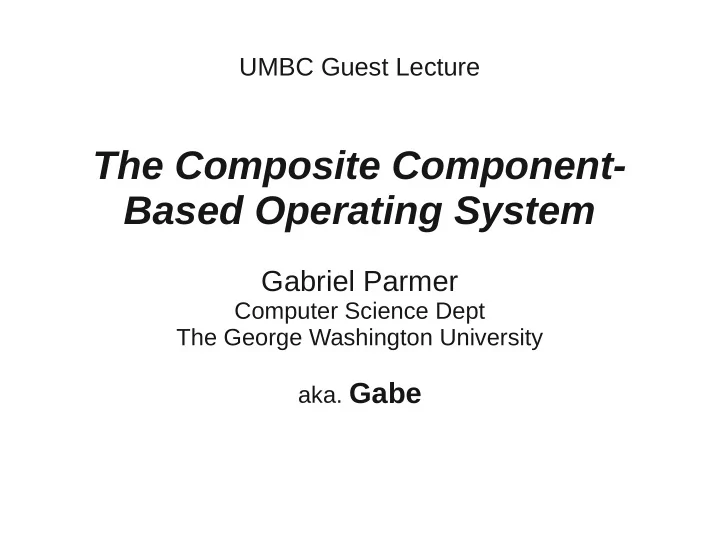

UMBC Guest Lecture The Composite Component- Based Operating System Gabriel Parmer Computer Science Dept The George Washington University aka. Gabe
Discussion encouraged... ● Please stop me at any moment ● Let me know if you haven't yet learned something or don't know a term ● Questions, questions, questions!
Today ● What is a component-based operating system? ● A design study of one of the most important mechanisms
System Structure ● System Structure: How different software parts 1) Are separated from each other ( Why?) 2) Communicate ● How does a system separate software using ● dual mode ● v irtual address spaces ● Implications on ● Security/Reliability ● What are some common system structures?
Monolithic System Structure ● Includes Unix/Windows/OSX Word Excel Browser “ User-Level ” System Call Operating System open(...) (File System, Networking, Kernel Memory Mgmt, Scheduling, ...) - most trusted - must work Hardware (CPU, Memory, Peripherals – hard drive, NIC, GPU) Dual mode protection? Virtual address spaces?
Monolithic System Structure ● Includes Unix/Windows/OSX 60 50 Word Excel Browser 40 “ User-Level ” 30 System Millions of Lines of Code Call 20 10 Operating System open(...) (File System, Networking, Kernel 0 Memory Mgmt, Scheduling, ...) - most trusted Windows 98 Windows Vista Windows 95 Windows XP - must work When's the last time you tried to get 50 MLOC to work??? Hardware (CPU, Memory, Peripherals – hard drive, NIC, GPU)
Microkernel System Structure File Memory App System Networking Management open(...) User level Kernel level <10 KLOC IPC ● Moves functionality from the kernel to “ user ” space ● Communication takes place between user servers using inter-process communication (IPC) ● Benefits: ● Easier to add functionality ● More reliable ( why? ) ● More secure ( why?) ● Down-sides???
Component-Based OS ● Component : – unit of functionality that exports an interface – uses other component's interfaces – User-level – separate virtual addr space ● Interface: Set of typed functions ● Even low-level functionality implemented in components – Scheduling, memory management, device drivers ● Kernel is minimal: not even scheduling!!! ● IPC for component communication
vs. Microkernel? ● Microkernel: – Put subsystems at user-level – Networking, File system, etc... – Focus : Separate a normal system into servers ● Component-Based system – Break system into small chunks of functionality – Glue together specific components specific to the goals of the system: customizability – Focus : Break system into small functionalities
IPC Implementation ● High frequency of “inter-process communication” – “inter-component communication” – Must be fast!!! ● What are the minimal hardware operations required to get a message from C 0 to C 1 ? – user/kernel and virtual addr space switches? ● How many thread switches? – Assuming separate threads per component
IPC Implementation II ● Asynchronous communication: UNIX Pipes ● C 0 : write(p1, buf0, sz); r = read(p2, buf0, sz) C 1 : read(p1, buf1, sz); r1 = write(p2, buf1, sz) ● Hardware operations? ● Thread switches?
IPC Implementation III ● Synchronous IPC – like function calls! C 0 : int foo(){return bar();} C 1 : int bar(){return 1;} ● Hardware operations? ● Thread switches? Assumptions?
IPC Implementation IV ● Synchronous IPC between threads C 0 : call(C 1 ,buf,sz) C 1 : recv(C 0 ,buf,sz); reply_recv(C 0 ,buf,sz) ● Hardware operations? ● Thread switches? Assumptions?
IPC Implementation V ● What is a thread? ● Synchronous IPC – thread migration C 0 : foo() {return bar();} C 1 : bar() {return 1;} ● No thread switches – same “schedulable entity” ● Hardware operations?
Composite CBOS ● See http://www.seas.gwu.edu/~gparmer/projects/composite/ ● Github repository for source code – We're accepting outside contributions! – TODO list in doc/ – smallish tasks
Virtual Machines I ● Do you know what these are? ● What is the structure of VMs?
Virtual Machines II ● A virtual machine host (the kernel) provides an interface identical to the underlying bare hardware ● Other guest kernels execute in user-mode ● The API for virtual machines is a copy of the machine!
Virtual Machines III System call hypercall identical Non-virtual Machine Virtual Machine (a) non-virtual machine (b) virtual machine
Virtual Machine: Benefits ● Fundamentally, multiple operating systems share the same hardware ● Protected from each other ● Some sharing of files ● Communicate with each other via networking ● Useful for development, testing ● Consolidation of many low-resource use systems onto fewer busier systems
Recommend
More recommend